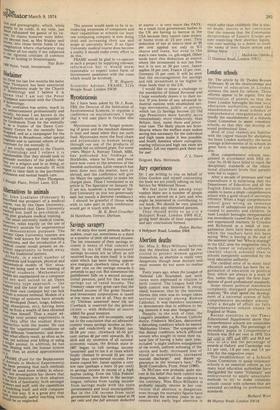( A lternatives to animals • John Linklater (February 9) described the
prospect of a medical course, run by the Open University, and suggested that Open University 1:lethod lent itself to pre-clinical, or
post graduate medical training. • lhe usual university medical course, 110w
ever, relies heavily on the use of a'''Doratory animals for experimental Cnci demonstration purposes. The rent Open University courses are readY well known for their teaching 'rnallovations, and the introduction of a ical course would present an exruent opportunity to break away r° ,n1 the traditional pattern. a', treacly, in a small number of ,,,,niversities and hospitals, physical and 't",tathematical models of 'live' situaa'.;')ns are being used in the training of e,lical students. Mathematical a,ls are manipulated on a computer Cu are well suited to an Open stniversity type approach — the hUdent and the tutor do not need to inave their own computer but can link w...,Frorn a remote terminal. Models of a h2ue range of systems have already 'a'ren developed (heart, lungs, kidneys, hatt.,g absorption, etc), having been fro tit up from a wealth of data obtained
,„
man himself. Thus a ,major adtha tage over animal experiments is i• t they offer the student direct nteraction with the model. He can 4Iter the 'experimental' conditions or F■Y different 'treatments,' and deterWhat 'effects result, as often as he • s, Yet without ever killing or using Vle animal. In addition, he has ra",e,n dealing with the human system tollte.r than an animal approximation ofPf;tA.„ ME (Fund for the Replacement h "Irlimals in Medical Experiments) as sho been pressing that such methods 110uki be used more widely in educa
„
but investigation has shown that th_Major limitation to their adoption sta,,z lack of familiarity, both amongst mants and staff, with the capabilities tisenlodelling itself, and with computer
i
s40.11 this way. It s a great pity that ql,,11 Potentially useful teaching tools h0 Potentially be so neglected.
The answer would seem to lie in introducing awareness of computers and their capabilities at schools (at least one computing company is now doing this) and increasing their use and scope at university level. If an Open University medical course does become a reality it should make every effort to do this.
FRAME would be glad to co-operate in such a project by supplying relevant information but it would seem reasonable to expect some form of Government assistance with the costs which would be involved.
T. W. Hegarty
Scientific Adviser, FRAME, 312a Worple Road, London SW20


































 Previous page
Previous page